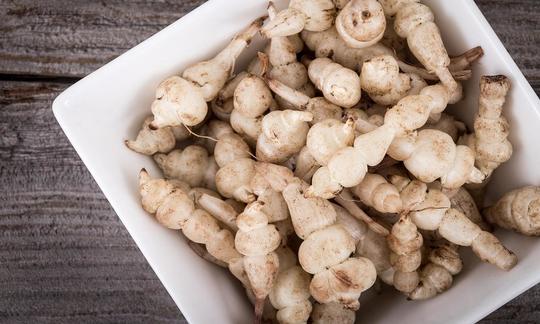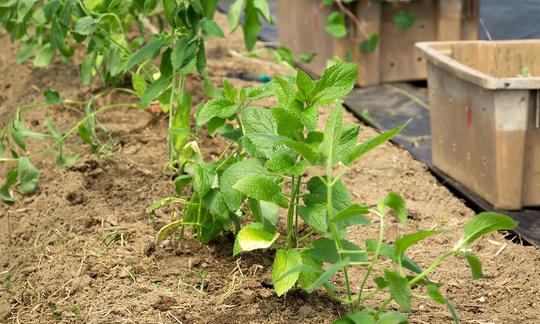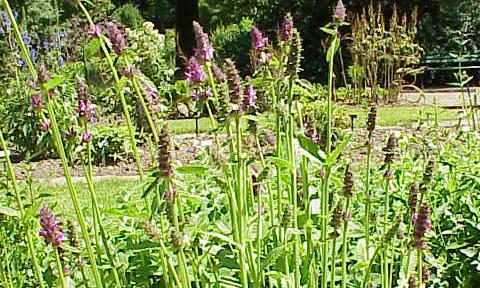Table of contents
The rediscovered tuberous beetroot ( Stachys affinis Bunge) is a delicate rarity, as its cultivation requires a lot of manual work and the harvest is small. Common names include Japanese potato or Stachys.
Use in the kitchen
First, clean the rhizomes (also known colloquially as roots or tubers) of soil and dirt using a root or mushroom brush under running water. Since the tuberous yarrow has a delicate skin, you do not need to peel the tubers. Small root buds and the ends can be carefully cut off.
The nutritious bulbous salsify has a delicate taste that is reminiscent of artichokes, cauliflower, salsify and nuts. The bulbs can be used to make delicious starters and side dishes. The tender and juicy vegetable can be cooked in a broth until al dente as a delicately seasoned dish or blanched for around 10 minutes. You can also prepare a delicious oven-baked vegetable or grate the bulbs fresh and raw into a salad. The bulbs can be ground dry and used as an additive for various doughs.
Bulbous chard also tastes good in a cream sauce ( vegan cream), gratinated or with pasta. You can pickle the roots in vinegar as a sweet and sour vegetable. Bulbous chard also goes well with leccho vegetables, a pan-fried vegetable with peppers. Recipes with asparagus and kohlrabi can also be prepared well with bulbous chard.
In Japan, the yarrow is pickled together with a perilla leaf. This dish is called 'chorogi'. It is a classic New Year's festive dish.
Vegan beetroot and yarrow recipe for beetroot carpaccio with roasted almonds
Ingredients (4 people): 3 medium-sized beetroots, 150 g beetroot and yarrow, a handful of almonds, 1 tbsp rapeseed oil, 1 tbsp balsamic vinegar, 1 tbsp agave syrup, 1 tbsp mustard, salt,pepper
Preparation: Peel the beetroot, slice very finely and mix with rapeseed oil, balsamic vinegar, agave syrup and mustard. Season with salt and pepper. Chop a handful of almonds and roast without adding any fat. Mix 150 g of carefully cleaned beetroot with the nuts and arrange on the beetroot. Garnish with sprouts of your choice (eg alfalfa sprouts or garden cress).
Vegan recipe for a simple root vegetable pan with chard
Ingredients (4 people): 400 g root vegetable pan, vegetable stock, 400 g chard, 2 tablespoons frying oil* (e.g. rapeseed oil), 1 garlic clove, salt, pepper, nutmeg, turmeric
Preparation: To do this, steam the bulbous chard in a little vegan vegetable stock for about 10 minutes. Drain the bulbous chard. In a frying pan, gently sauté 400 g of spinach or chard with two tablespoons of heat-stable cooking oil and a finely chopped garlic clove. Season to taste with salt, pepper, nutmeg and a little turmeric. Tip: Instead of spinach or chard, you can also use the young shoots and leaves of the stinging nettle or willowherb.
Goes well with: kohlrabi schnitzel or potatoes with mushroom and bean gravy.
* When frying, use oils with a high content of saturated fatty acids and try to cook as gently as possible at low heat. This will prevent the formation of aldehydes that are harmful to health. 3
Vegan recipes with tuberous beetroot can be found under the note: " Recipes that have the most of this ingredient ".
| Not only vegans or vegetarians should read this: Vegans often eat unhealthily. Avoidable nutritional mistakes. |
Purchasing - Storage
As long as the ground is not frozen, you can harvest fresh bulbous yarrow all winter long.
Tuberous yarrow is a rare specialty in the shops. With a little luck, it is available in season from October to March. During the high season from mid-November to February, it is best to ask in delicatessens, as they may have the tuberous yarrow in their range during the holidays. Tuberous yarrow can also be purchased from the foundation for old varieties Pro Specie Rara (prospecierara.ch).
However, in German-speaking countries, tuberous chard is not very well known, which is why demand and supply are low. As a result, it is rarely available at weekly markets or in retail stores, and is unlikely to be available from major retailers such as Coop, Migros, Denner, Volg, Spar, Aldi, Lidl, Rewe, Edeka, Hofer, Billa or organic supermarkets such as Denn's Biomarkt and Alnatura. However, you can buy tuberous chard in health food stores or small natural food shops - organic quality included. The vegetable is of no interest to major retailers because its thin skin means it dries out quickly and discolors.
If you would like to try tuberous fenugreek, it is best to order it directly from a local producer. The price for a kilo of tuberous fenugreek is around 20 euros.
You can order bulbs for tuberous yarrow via the online shop on Fritz Berger 's website (spezberger.ch). Seeds or potted plants for tuberous yarrow can be purchased online or in well-stocked garden centers. From April, tuberous yarrow can also be purchased as a pre-grown garden plant in garden centers. If you find undamaged tuberous yarrow at a weekly market, you can plant it in a flowerpot.
The easiest option currently seems to be to buy the tuberous yarrow online and cultivate it further (see chapter Cultivation-Harvest).
The availability of bulbous fenugreek varies depending on the size of the store, catchment area, etc. Our recorded food prices for the DA-CH countries can be found above under the ingredient image - and by clicking on them you can see their development at various suppliers.
Storage tips
The white yarrow tubers, which can be up to 8 cm long, do not keep for long. They should be processed immediately after harvesting - ideally on the same day as harvesting, when they are particularly crisp.
If you still want to store the tubers, you can store them in buckets or boxes filled with moist coconut fibers and wood chips or soil (moist sand probably works too) until December. After that, the tubers are still edible, but usually start to sprout. 1
Ingredients - Nutritional values - Calories
There are only a few studies on the ingredients so far. We could only find data for dried tuberous betony:
The dried tuberous yarrow provides 195 kcal/100g. The largest proportion of macronutrients are carbohydrates at 36.9%. Proteins make up about 11% and fat at 0.53%. 4
The tuberous beetroot contains stachyose, an oligosaccharide consisting of galactose, fructose and glucose. 4 This slightly sweet-tasting substance is also found in mung beans and other mint family plants such as pigeon peas.
The tuber provides 1.38 g of iron per 100g. This is comparable to oyster mushrooms, which have 1.3 mg per 100g. This corresponds to 10% of the daily requirement of iron. 4
It also contains significant, but small amounts of potassium (23.6 g/100g), calcium (3.83 g/100g) and magnesium (2.22 g/100g). Sodium is the most abundant at 75.8 mg/kg. 4
The complete ingredients of bulbous zest, the coverage of the daily requirement and comparison values with other ingredients can be found in our nutrient tables. In the article Nutrients explained you will get a detailed insight into the topic.
Effects on health
Is tuberous yarrow healthy? A review from 2024 provides answers: Tuberous yarrow has a special fatty acid profile and thus differs from its conspecifics. The polyunsaturated fatty acids it contains have a preventive effect against cardiovascular diseases, cancer, diabetes, obesity, rheumatoid arthritis, autoimmune diseases, depression and asthma. The fatty acid profile of tuberous yarrow is in the optimal range with an omega-6 to omega-3 ratio of 1:1 to 4:1. 4
In the laboratory and on rats, an antioxidant and antimicrobial effect of the tuberous beetroot was observed. Researchers were also able to observe positive effects on a diet high in fat and cholesterol in a test on rats. The administration of tuberous beetroot extract improved blood lipid levels and the effects of obesity. 4
Scientists observed an improvement in cognitive performance and a reduction in a previously induced memory disorder in rats, also using the root beetroot extract. The researchers concluded that the extract could improve memory performance in humans and prevent dementia. 4
The effects of the root yarrow extract on the intestinal microbiome were studied in mice. The good bacteria increased and the harmful ones decreased. The stachyose in root yarrow is a prebiotic and thus promotes eubiosis - the balance of microorganisms in the intestine. 4
Among other things, anti-cancer and anti-inflammatory properties of the tuberous betony have also been observed. These properties are attributed in particular to the bioactive ingredients it contains. 4
Secondary plant substances
Many of the health effects of the bulbous yarrow can be attributed to the secondary plant substances it contains. Our article on secondary plant substances provides an overview of the classification of the substance groups, their occurrence in food and possible effects on humans. Bulbous yarrow contains the following secondary plant substances, among others: 4
- Isoprenoids: terpenes (diterpenes, triterpenes, iridoids (such as harpagide, 8-O-acetyl-harpagide, melittoside and 5-O-allosyloxyl-aucubin), essential oils)
- Polyphenols : Phenylethanoid glycosides (PhGs; such as verbascoside, leucosceptoside A, martynoside and stachysoside C), saponins (Sieboldii saponin A), tannins (gallic acid, epigallocatechin, gallocatechin, catechin, epicatechin, epicatechin gallate, ellagic acid (only in herbs) and catechin gallate (only in tubers))
These ingredients characterize the taste of the tuberous betony. Verbascoside is particularly valuable because it has anti-inflammatory, anti-cancer, antioxidant and antihistamine effects. Other phenylethanoids contained in the plant also have antioxidant and estrogenic effects. Iridoid glycosides such as harpagide, 8-O-acetyl-harpagide, 5-O-allosyloxyl-aucubin and melittodis have antioxidant, anti-cancer, antiviral, anti-inflammatory, pain-relieving and anti-osteoporosis effects. A total of 200 bioactive compounds have been identified. 4
However, it should be noted that the composition of the secondary plant substances in tuberous yarrow can vary depending on the variety, time of harvest, preparation and growing conditions. Therefore, quantities are only of limited use and should only be understood roughly.
Dangers - Intolerances - Side effects
Stachyose cannot be digested by the human small intestine using its own enzymes, which is why the food pulp reaches the large intestine unchanged. There, intestinal bacteria break down the stachyose, which can lead to flatulence. 4
Folk medicine - naturopathy
In various countries, the sedum is used in naturopathy. Many species of the genus Stachys were already used in traditional medicine in ancient Egypt. 4
The tuberous betony in particular is often used in Chinese natural medicine: to treat colds, heart disease, pain, brain damage caused by lack of oxygen, dementia and gastrointestinal diseases. 7
Ecological footprint - animal welfare
Even if specific data on the ecological footprint of the tuberous yarrow is not precisely documented, the ecological impact is probably positive. We assume that consumption of the plant is generally associated with a small CO 2 footprint and water footprint. Root vegetables have an average small CO 2 footprint of 0.4 kg CO 2 eq/kg. 2 In addition, the tuberous yarrow is a fairly undemanding crop. 4 However, the soil should never dry out completely - so the water footprint is heavily dependent on the prevailing climate. 1
In general, it is a good idea to buy regional, seasonal vegetables, preferably unpackaged, from direct sales (e.g. weekly markets). 6 However, most greenhouse gases are caused by land use changes and on the farm or in the production facility. These two aspects of the ecological footprint account for 80% of all emissions for most foods. 2
For detailed explanations of various sustainability indicators (such as ecological footprint, CO2 footprint, water footprint), see our article: What does the ecological footprint mean?
Worldwide occurrence - cultivation
The bulbous woundwort originally comes from central and northern China, where it has been found in agricultural landscapes since the 13th century. Before it was brought to Europe, a close relative, the marsh woundwort, was collected there in the wild. In the 18th century, bulbous woundwort began to be cultivated in Europe. 4
The first cultivation was in France. At the end of the 19th century, the tuberous yarrow came to the botanical garden in Paris via a Japanese physicist. A gardener in the small French town of Crosne near Paris planted these tuberous yarrow, which is where the name 'Crosne du Japon' comes from. From there, the plant spread to local home gardens. 1
In the early 20th century, the bulbous beetroot was very popular. However, in the 1970s, a problematic viral disease occurred and, together with the rapid spread of the bulbous beetroot (invasive character), this crop lost its importance. As interest in "new", natural, sustainable products is growing in many areas, the bulbous beetroot is also receiving more attention again as a supplier of traditional or innovative applications (functional food). 4
Cultivation - Harvest Growing
tuberous yarrow is easy in Central Europe, as it can also cope with normal garden soil. A well-drained, slightly sandy and moist soil is important, as well as plenty of space so that other plants do not overgrow it. Tuberous yarrow prefers a spot in the sun or partial shade. Sowing takes place in autumn by seed or by division in spring. 5 The tubers are planted in the soil about 10 cm deep from March, or the plants are grown in pots from February. Tuberous yarrow needs a row spacing of 50 cm and 20-40 cm in the row. The perennial plant can remain in the bed for two years, after which the soil becomes tired. As tuberous yarrow also competes with itself, it should be harvested regularly. 1 In Central Europe, tuberous yarrow only flowers sparsely and hardly produces ripe seeds.
The 1-2 cm thick tubers only form when the nights are longer than the days (in short days). Therefore, you have to wait until the end of October to harvest.
As long as the ground is not frozen, you can continuously harvest exactly as much as you need. 1
Further information
Bulbous woundwort belongs to the genus Stachys in the mint family (Lamiaceae). The more than 300 species of woundwort are found in temperate and tropical regions of the Mediterranean, Asia, America and southern Africa worldwide. 7 Closely related to bulbous woundwort is marsh woundwort ( Stachys palustris), which is native to Central Europe. Like bulbous woundwort, it forms underground runners with bulbous thickenings at the tip. 5 In addition to marsh woundwort, wood woundwort ( Stachys sylvatica), woolly woundwort ( Stachys byzantina) and upright woundwort ( Stachys recta) are also found in Central Europe.
Alternative names
Alternatively, the tuberous woundwort is also called Chinese artichoke, Japanese tuber, Japanese potato, tuberous potato, Crosne du Japon or Stachy. The now outdated scientific name Stachys sieboldii was created in honor of the German-Dutch Japan researcher and botanist Philipp Franz von Siebold. Another scientific synonym is Stachys tuberifera.
The English name for the artichoke is simply Stachys. Alternative names in English are hedgenettle, heal-all, self-heal, woundwort, betony and lamb's ears. The tuberous artichoke in particular is also known in English as 'Chinese artichoke', 'Japanese artichoke', 'crosne', 'knotroot' or 'artichoke betony'.
The name 'Stachys' is derived from the Greek 'Stachys', meaning 'ear', and refers to the inflorescences, which resemble those of common wheat. 4 'Affinis' is a Latin word meaning 'related'. This term could be a reference to the many species of bee-grass.
Bibliography - 7 Sources (Link to the evidence)
| 1. | Heistinger A. Arche Noah Handbuch Bio-Gemüse. 4. Auflage. Löwenzahn; 2010:404-507. |
| 2. | Ritchie H. You want To Reduce the Carbon Footprint of your Food? Focus on What You Eat, not whether your Food is Local. OurWorldInData.org. 2024. |
| 3. | Peng CY, Lan CH et al. Effects of Cooking Method, Cooking Oil, and Food Type on Aldehyde Emissions in Cooking Oil Fumes. Journal of Hazardous Materials. 2017;324:160-167. |
| 4. | Wiśniewski R, Harasym J. Chinese Artichoke (Stachys affinis Bunge): The Nutritional Profile, Bioactive Profile and Food Applications—A Review. Molecules. 2024;29(15):3525. |
| 5. | Bown D. Kräuter: Die grosse Enzyklopädie. Zweite, vollständig überarbeitete Auflage. (Royal Horticultural Society, ed.). DK, Dorling Kindersley Verlag GmbH; 2015. |
| 6. | Müller-Lindenlauf M, Zipfel G et al. CO2-Fussabdruck und weitere Umweltwirkungen von Gemüse aus Baden-Württemberg. IFEU Institut für Energie- und Umweltforschung Heidelberg GmbH. 2013. |
| 7. | Tomou EM, Barda C, Skaltsa H. Genus Stachys: A Review of Traditional Uses, Phytochemistry and Bioactivity. Medicines. 2020;7(10):63. |












Comments